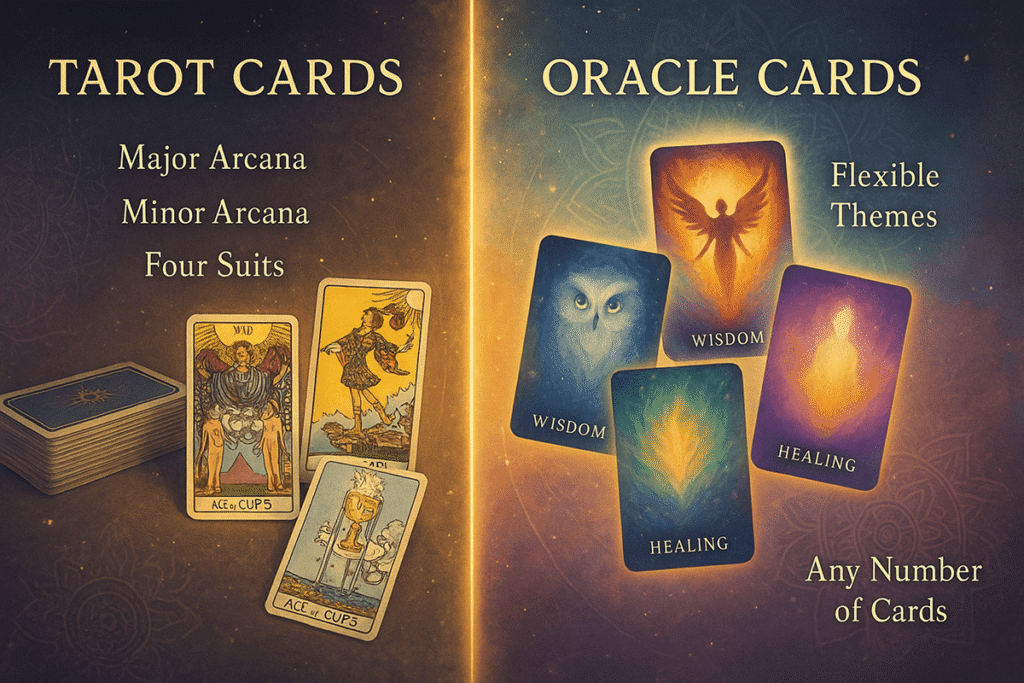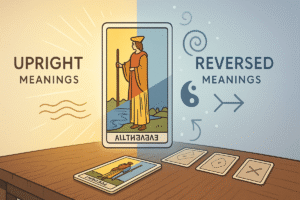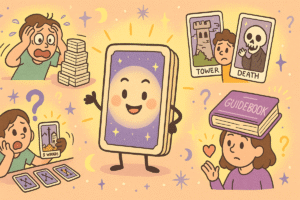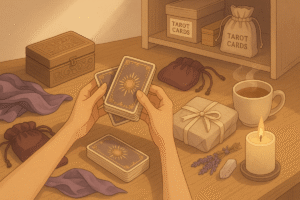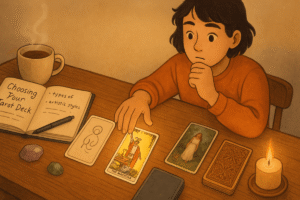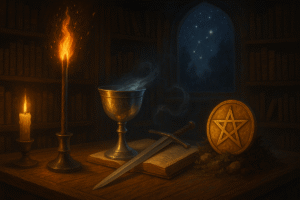Table of Contents
Walking into a metaphysical shop for the first time can feel overwhelming. Shelves lined with countless decks, each promising insights and guidance. But here’s what I’ve noticed after years of exploring different divination tools: most people get confused about the fundamental differences between tarot and oracle cards. They’re both used for guidance and reflection, yet they operate in completely different ways.
Understanding these differences isn’t just about choosing the right deck. It’s about finding a practice that resonates with how you think, process emotions, and approach personal growth. Some people thrive with structure and symbolism, while others prefer intuitive freedom. Let me walk you through what makes each system unique.
Understanding Tarot Cards
Tarot operates on a fixed system that has remained remarkably consistent for centuries. Every traditional tarot deck contains exactly 78 cards, divided into two main categories: the Major Arcana and Minor Arcana. The Major Arcana consists of 22 cards representing major life themes and spiritual lessons, from The Fool’s journey of new beginnings to The World’s completion and fulfillment.
The Minor Arcana mirrors a regular playing card deck but with deeper symbolic meaning. It contains 56 cards across four suits: Cups (emotions and relationships), Wands (passion and creativity), Swords (thoughts and communication), and Pentacles (material world and resources). Each suit runs from Ace through Ten, plus four court cards: Page, Knight, Queen, and King.
This structured approach creates a comprehensive language of symbols. When you pull The Tower card, for example, you’re working with centuries of established meaning around sudden change and revelation. The system encourages you to explore how these archetypal energies might be reflecting your current situation or internal state.
What strikes me most about tarot is how this framework provides both boundaries and freedom. The meanings are established, but how they apply to your life remains entirely personal. It’s like having a vocabulary that helps you articulate feelings or situations you might struggle to express otherwise.
Exploring Oracle Cards
Oracle cards operate from a completely different philosophy. There are no rules about how many cards should be in a deck, what themes to explore, or how the system should work. A deck might have 30 cards, 50 cards, or even 100 cards. The themes can range from angels and goddesses to animals, crystals, or abstract concepts like “inner wisdom” or “releasing fear.”
Each oracle deck is essentially its own complete system created by the author or artist. One deck might focus on daily affirmations with gentle, encouraging messages. Another might explore shadow work with more challenging prompts for self-reflection. Some oracle decks include detailed guidebooks with specific meanings, while others encourage purely intuitive interpretation.
I find oracle cards particularly appealing when I want something more straightforward or themed around a specific area of growth. If you’re working through relationship patterns, there are oracle decks specifically designed for that exploration. Feeling disconnected from nature? There are decks that help you reconnect with natural cycles and elemental energies.
The flexibility can be both liberating and sometimes overwhelming. Without established meanings to fall back on, you rely more heavily on your intuition and personal associations with the imagery and words.
Key Structural Differences
The most obvious difference lies in the systematic approach. Tarot follows strict structural rules that create consistency across different decks and interpretations. Whether you’re using the classic Rider-Waite-Smith deck or a modern artistic interpretation, The Hermit card will always represent introspection and inner guidance. The Ten of Cups will always connect to emotional fulfillment and harmony.
Oracle cards embrace variety and personal expression. Two oracle decks with similar themes might approach the subject matter in completely different ways. One “goddess” deck might focus on empowerment and strength, while another emphasizes nurturing and intuition. There’s no standard template to follow.
This structural difference affects how you learn and develop relationships with the cards. Tarot requires more initial study to understand the traditional meanings and symbolic connections. Oracle cards often feel more immediately accessible but might require deeper personal work to develop meaningful interpretations.
Perhaps the most significant difference is how the systems handle complexity. Tarot readings can explore multiple layers of meaning through card combinations, positions, and elemental associations. Oracle cards typically deliver more direct, singular messages that stand alone rather than building complex narratives.
How Each System Approaches Guidance
Tarot tends to offer what I call “layered reflection.” The cards work together to create a fuller picture, encouraging you to consider multiple perspectives on a situation. A three-card spread might show what you need to release, what to embrace, and what action to take. Each card informs and influences the others.
The system excels at helping you examine the psychological and spiritual dimensions of your experiences. It asks you to consider not just what’s happening, but why it might be happening and how you can work with the energies at play. The structured symbolism provides a framework for deeper contemplation.
Oracle cards typically offer more direct inspiration or validation. They tend to speak to where you are right now, providing affirmation, encouragement, or gentle redirection. The messages are usually clearer and require less interpretation, which can be exactly what you need during times when life feels confusing or overwhelming.
I’ve noticed that oracle cards often serve as excellent conversation starters with your intuition. They provide a focal point for meditation or journaling without requiring extensive background knowledge. You can simply sit with the image and words, allowing whatever comes up to guide your reflection.
Learning Curves and Accessibility
Starting with tarot involves more of a learning commitment. Understanding the Major Arcana journey, the four suits, and how different cards relate to each other takes time and practice. Many people find this depth rewarding, but it can feel daunting initially.
The rich symbolism in tarot cards provides endless opportunities for discovery. You might notice new details in familiar cards after months of working with them. This depth creates a sense of growing partnership with the deck over time.
Oracle cards offer immediate accessibility. You can often start working with a new oracle deck right away, even without reading the guidebook. The messages are typically designed to be understood intuitively, making them particularly appealing for people who prefer to trust their first impressions.
However, this accessibility can sometimes feel limiting over time. While oracle cards might provide beautiful inspiration, they don’t always offer the same opportunities for deeper psychological exploration that tarot’s structured system encourages.
Choosing What Fits Your Practice
The choice between tarot and oracle cards often comes down to how you prefer to process information and what kind of guidance feels most helpful. If you enjoy studying symbolism and building understanding over time, tarot’s structured approach might feel more satisfying.
Some people find comfort in tarot’s established framework. Knowing that The Star card has represented hope and renewal for generations can feel reassuring and connecting. You’re participating in a tradition that has helped people navigate life’s challenges for centuries.
Oracle cards might appeal more if you prefer flexibility and immediate insight. They’re particularly useful when you want guidance around specific themes or need encouragement rather than complex analysis.
I think there’s also something to be said for your current life phase. During periods of major change or confusion, oracle cards’ direct messages might feel more supportive. When you’re ready for deeper self-examination or want to understand patterns in your life, tarot’s complexity becomes more valuable.
Many people eventually work with both systems, choosing based on what feels appropriate for their current needs. There’s no rule saying you have to commit to one approach exclusively.
Making Your Decision
Consider starting with whichever system draws your attention more naturally. If you find yourself fascinated by symbolism and don’t mind a learning curve, tarot might be your path. If you want something you can begin using immediately for inspiration and reflection, oracle cards could be perfect.
Think about your personality and how you prefer to receive guidance. Do you like having multiple perspectives to consider, or do you prefer clear, straightforward messages? Do you enjoy studying and building knowledge over time, or do you prefer trusting your immediate intuitive responses?
Remember that neither system predicts the future or provides definitive answers about your life decisions. Both serve as tools for reflection and self-discovery. The “right” choice is simply the one that helps you connect more deeply with your own wisdom and intuition.
Your divination practice should feel supportive and enriching, not stressful or overwhelming. Whether that means diving into tarot’s rich symbolic language or embracing oracle cards’ intuitive freedom, trust what feels authentic for your personal growth journey.
Frequently Asked Questions
Can I use both tarot and oracle cards together in the same reading?
Yes, many readers combine tarot and oracle cards to create more comprehensive readings. You might pull an oracle card at the beginning to set the overall theme, or draw one at the end to provide closure or a summary message for the reading. The two systems complement each other well, with tarot offering detailed insights and oracle cards providing broader themes or emotional context.
Do I need to be gifted a tarot deck to start reading, or can I buy my own?
The superstition that you need to be gifted a tarot deck is untrue. You can absolutely buy your own deck and begin working with it right away. The most important thing is taking time to get to know your deck and build a relationship with the cards through regular practice.
Which is better for beginners, tarot or oracle cards?
Oracle cards are often considered more beginner friendly because they require less study and memorization. The meanings are usually more straightforward and can be understood intuitively without extensive background knowledge. However, this doesn’t mean oracle cards are only for beginners, as many experienced readers use them regularly in their practice.
How long does it take to learn tarot compared to oracle cards?
While tarot initially requires memorization of card meanings and structures, you can develop a basic understanding fairly quickly. True mastery comes from blending intuition with the structured system over time, which rewards you with a lifelong tool for exploration. Oracle cards can typically be used effectively right away, though developing deeper interpretations still takes practice.

